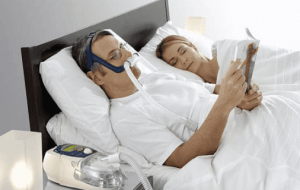Different types of Positive airway pressure devices
Positive airway pressure devices (PAP) are common in treating sleep apnea at home and respiratory failure in hospitals. PAP machines work by gently blowing pressurized air through the airway to give the minimum amount of pressure to keep the throat open.
These machines only work during sleep obstructions due to the fact that all muscles relaxing, including ones in the throat. Since PAP machines are medical devices, all PAP units require a physician’s prescription and approval from the Food and Drug Administration (FDA). There are 3 types of PAP machines.
- CPAP
- APAP
- BiPAP/VPAP
CPAP
 The continuous positive airway pressure machine, also known as CPAP, provides unobstructed breathing by delivering a constant stream of air through a hose connected to a nasal mask, nasal pillow or full-face mask.
The continuous positive airway pressure machine, also known as CPAP, provides unobstructed breathing by delivering a constant stream of air through a hose connected to a nasal mask, nasal pillow or full-face mask.
The mask must secure to the face so that no air escapes. This constant level increases air pressure in the throat so the airway does not collapse during inhalations while sleeping.
APAP
APAP or automatic positive airway pressure machine circulates air in a range of set pressures, adjusting automatically on a breath-by-breath basis proving the minimum amount of pressure needed to keep airways open.
This machine uses algorithms that sense subtle changes in breathing and fluctuates throughout the night, automatically adjusting to the patient’s need at that moment. APAP machines and adjusts itself to the best pressure setting at any time of the night.
CPAP and APAP machines can use the same prescription interchangeably.
BiPAP/VPAP
Bilevel or variable level machines (BiPAP/VPAP) blows air in two levels, one for inhalation (IPAP) and one for exhalation (EPAP). This method is used in situations where marked difficulty breathing is present.
- IPAP stands for inspiratory positive airway pressure which delivers a high level of pressurized air as the patient inhales.
- EPAP or expiratory positive airway pressure delivers a lower level or pressure during exhalation. There are three settings:
- S (Spontaneous) – Spontaneous mode circulates from IPAP to EPAP when the IPAP sensors identify spontaneous inspiratory effort.
- T (Timed) – In timed mode, the circulation from IPAP to EPAP is solely machine-triggered and is set at a rate of breaths per minute.
- S/T (Spontaneous/Timed) – This mode uses the spontaneous mode and timed mode conjunctively by initiating IPAP on the patient when inspiratory effort is detected. The timed mode auxiliary assures that the minimum number of breaths per minute is achieved even if they fail to breathe spontaneously.
BiPAP machines require a separate prescription from a CPAP.
CPAP and BiPAP machines must be monitored by doctors to ensure the right device and method is used to assist the patient breathe. This monitoring can determine which method is best for the patient and determine if the patient needs/can switch from one device. Compared to other anti snoring devices, such as the SnoreRx and ZQuiet, these types of devices are much more expensive and require a prescription.

